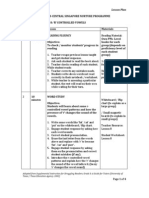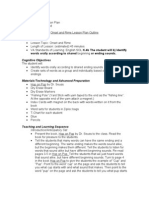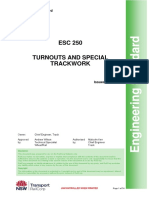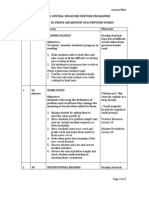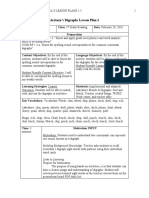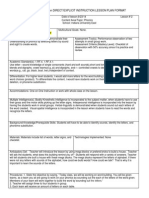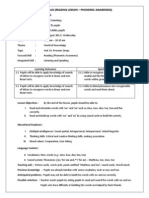Lesson 1 - Sight Words
Lesson 1 - Sight Words
Uploaded by
Nurture ProgrammeCopyright:
Available Formats
Lesson 1 - Sight Words
Lesson 1 - Sight Words
Uploaded by
Nurture ProgrammeCopyright
Available Formats
Share this document
Did you find this document useful?
Is this content inappropriate?
Copyright:
Available Formats
Lesson 1 - Sight Words
Lesson 1 - Sight Words
Uploaded by
Nurture ProgrammeCopyright:
Available Formats
Lesson Plan STARHUB-CENTRAL SINGAPORE NURTURE PROGRAMME NURTUREPLUS LESSON 1: SIGHT WORDS Part 1 Duration Lesson Materials Reading
Material: Reading Material: Own PM+ Level books for each group (depends on proficiency level of each student group) 1 book for teacher, 1 for pupil
10 minutes FLUENCY Objective: To check / monitor students progress in reading 1. Start lesson by reading an excerpt of a book appropriate for the childs level. 2. Ask each student to read the book aloud. 3. As student reads: - Teacher will correct wrongly pronounced word(s). - Students will write down words not read correctly in their small notebooks. 4. While teacher is assessing a particular student, the rest will read in pairs while waiting for their turn.
Student Worksheet Lesson 1
10 minutes WORD STUDY Objective: Students will learn 5 new high frequency words. For this lesson the recommended words are: come, said, very, there and people (up to teacher discretion) 1. Introduce high frequency words to students by telling them that some common words do not follow spelling rules. 2. Show some examples of sight words that students often see for e.g. are, the and you. 3. Introduce the 5 new words on board and asks students, in pairs, to search from the given reading material. 4. Ask students at random to try reciting any Appendix B: Excerpt from Reading Material: Max and Jake Appendix C: 5 word cards with the 5 high frequency words Whiteboard / Flip chart Student WorksheetLesson 1
Adapted from Supplemental Instruction for Struggling Readers, Grade 3: A Guide for Tutors (University of Texas / Texas Education Agency, 2002)
Page 1 of 4
Lesson Plan STARHUB-CENTRAL SINGAPORE NURTURE PROGRAMME NURTUREPLUS LESSON 1: SIGHT WORDS of the given words. 5. Show the students each of the word cards (3 are found in the book said, come, very) with the high frequency words and read them aloud to the students. 6. Make students repeat after the teacher together. 7. In groups of 4, make students spell out the word together and repeat saying the words till they pronounce them correctly. 8. Go around the class to check on student individually. 9. Instruct students to write the new 5 high frequency words into their small book to record new words learnt.
30 minutes INSTRUCTIONAL READING Objective: Students will learn to use a basic graphic organiser to identify important information while reading a text. Before reading: 1. Pass the books and graphic organisers to students. 2. Ask students at random to guess what the story is about by looking at the title and its cover picture. 3. Lead students on what they know about the story (have they read about it before?) 4. Instruct the students to work in groups of 4. 5. Introduce 3-5 new vocabulary words and get students to guess the meaning of each word as they read the book later. Reading: 1. Make students read books in their own
Reading Material: The Ant and the Dove (from PM+ Level 15) Note to teacher: For lower ability students, could use a book suited for them or choose an excerpt of the book) Student Worksheet: Lesson 1 Teacher Resource Lesson 1 Large Mahjong Paper (for group sharing) 3-5 vocabulary word cards
Adapted from Supplemental Instruction for Struggling Readers, Grade 3: A Guide for Tutors (University of Texas / Texas Education Agency, 2002)
Page 2 of 4
Lesson Plan STARHUB-CENTRAL SINGAPORE NURTURE PROGRAMME NURTUREPLUS LESSON 1: SIGHT WORDS groups and fill in the given graphic organisers on their own as they read along. 2. Instruct students to write down the Who, Where and Why as required on the bigger mahjong paper for them to present later. After reading: 1. Ask students to close the books and make each group present different parts of the graphic organiser. 2. Get feedback from other groups to check accuracy of answer from presenting groups. 3. Give students the meanings of the 3-5 new vocabulary words and reward groups with the most number of accurate answers. 4. Review the vocabulary words and discuss how each word was used in the text. 5. Ask students to record new words in notebook.
10 minutes WRITING Objective: Students will improve writing fluency (speed and accuracy) 1. Review the new words learnt in the lesson and encourage students to write as many words as they can remember from the words they have seen or read. 2. Time students as they write the words in their writing books / worksheets. 3. Ask each student to read the words they have written and share to the class. 4. Monitor and help students with their spelling and pronunciation. Student WorksheetLesson 1
Adapted from Supplemental Instruction for Struggling Readers, Grade 3: A Guide for Tutors (University of Texas / Texas Education Agency, 2002)
Page 3 of 4
Lesson Plan STARHUB-CENTRAL SINGAPORE NURTURE PROGRAMME NURTUREPLUS LESSON 1: SIGHT WORDS 5 30 minutes WORD BUILDERS Objective: Students will improve in their practice of phonics, spelling and vocabulary. 1. Instruct students to work in pairs. 2. Give each pair of students a worksheet containing 5 sentences with blank spaces for each sentence. (e.g. She took a leaf in her beak and let it fall into the water. ) 3. Make students fill in the blanks by spelling out the words using the tiles. 4. After that, make each pair create a new word / words by taking out a letter from the underlined words e.g beak becomes weak, fall becomes wall, tall etc) 5. Instruct students to create as many new words as possible. 6. Ask each pair to read the words they have made. 7. Assist students with spelling and correct pronunciations. Letter tiles / cards (like Scrabble tiles or UNO card style) Student worksheets / Large mahjong papers for each pair of students Appendix E: Word Builder Game Appendix F: Letter Tiles
Adapted from Supplemental Instruction for Struggling Readers, Grade 3: A Guide for Tutors (University of Texas / Texas Education Agency, 2002)
Page 4 of 4
Teachers Resource STARHUB-CENTRAL SINGAPORE NURTURE PROGRAMME NURTUREPLUS LESSON 1: SIGHT WORDS Appendix A1 Excerpt from A friend for Max
Grandad! Grandad! shouted Max. Look at the big truck! Some men are taking beds into the house over the road. A new family is moving in, said Grandad. A car came up the road to the house. A big boy and a big girl got out of the car. The childrens father got out of the car, too. Oh Grandad, said Max. Some children are moving into that house. I want a friend to play with, but they are too old for me. Grandad and Max went to see the new family. The big girl came to the door. Hello, said Max. Im Max and Im six.
Page 1 of 5
Teachers Resource STARHUB-CENTRAL SINGAPORE NURTURE PROGRAMME NURTUREPLUS LESSON 1: SIGHT WORDS
Appendix B1: Sight Words Excerpt from Max and Jake
I cant swim, said Max. I can help you, said Jake. Im good at swimming. Can Grandad come with us? said Max. Yes, smiled Jakes Mum. At the big swimming pool, Jake got into the water. He loved swimming. Max did not want to get in at first. He sat with his feet in the water and looked at Jake. Jake was swimming up and down the pool. He kicked his feet and made big splashes. Jake swam over to Max. I cant run very fast, he said, but I can swim fast.
Page 2 of 5
Teachers Resource STARHUB-CENTRAL SINGAPORE NURTURE PROGRAMME NURTUREPLUS LESSON 1: SIGHT WORDS Appendix C1 Sight Word Cards
come
very
said
there
people
the
Page 3 of 5
Teachers Resource STARHUB-CENTRAL SINGAPORE NURTURE PROGRAMME NURTUREPLUS LESSON 1: SIGHT WORDS Appendix E1: Word Builder 1 Group Work Activity 1 Fill in the blanks with the correct words from the box. (taken from Advanced Reading Grade 2- Creative Teaching Press page 60)
same
take
rows
food
look
A shark is an amazing fish with __________________ and ________________ of teeth. Some sharks have more than 20 rows of teeth. Sharks lose lots of teeth when they are busy eating. Some sharks lose a tooth every ten days. When a shark loses a tooth, another one moves forward to ___________________ its place. Sharks use their teeth to catch and eat _________________. But not all shark teeth __________________ the ____________________. Sharks teeth come in different shapes and sizes.
Activity 2 Create new words (as many as possible) from the words in the boxes above by adding a letter in front or at the back. For e.g. weak becomes beak or wear
Page 4 of 5
Teachers Resource STARHUB-CENTRAL SINGAPORE NURTURE PROGRAMME NURTUREPLUS LESSON 1: SIGHT WORDS Appendix F1: Letter Tiles
A F K P U Z
B G L Q V
C H M R W
D I N S X
E J O T Y
Page 5 of 5
Students Worksheet STARHUB-CENTRAL SINGAPORE NURTURE PROGRAMME NURTUREPLUS LESSON 1: SIGHT WORDS Name: _________________________________________________________ Date: _____________________
Part 1: Reading Fluency Write down the words you had difficulty pronouncing in the box below. Book title: _______________________________________________
Part 2: Word Study Write the new sight words as taught by your teacher in the box below.
Part 3: Instructional Reading
Page 1 of 4
Students Worksheet STARHUB-CENTRAL SINGAPORE NURTURE PROGRAMME CENTRAL NU NURTUREPLUS LESSON 1: SIGHT WORDS Story: The Ant and the Dove From the title and the picture on the front cover, what is the story about?
Who are the main characters?
Where does the story take place?
What is the main problem in the story? Why is the character like
that?
What happens next?
How does the story end?
Page 2 of 4
Students Worksheet STARHUB-CENTRAL SINGAPORE NURTURE PROGRAMME NURTUREPLUS LESSON 1: SIGHT WORDS
Activity 1 Fill in the blanks with the correct words from the box.
(taken from Advanced Reading Grade 2- Creative Teaching Press page 60)
same
take
rows
food
look
A shark is an amazing fish with __________________ and ________________ of teeth. Some sharks have more than 20 rows of teeth. Sharks lose lots of teeth when they are busy eating. Some sharks lose a tooth every ten days. When a shark loses a tooth, another one moves forward to ___________________ its place. Sharks use their teeth to catch and eat _________________. But not all shark teeth __________________ the ____________________. Sharks teeth come in different shapes and sizes.
Vocabulary What are the new words you have learnt today?
Page 3 of 4
Students Worksheet STARHUB-CENTRAL SINGAPORE NURTURE PROGRAMME NURTUREPLUS LESSON 1: SIGHT WORDS Part 4: Writing Write as many CVC words (from your reading) as you can in the box below in the shortest time possible.
Check Time: How do you feel after todays lesson? (Tick the box)
Why do you feel so? ----------------------------------------------------------------------------------------------------------------What have you learnt today? -----------------------------------------------------------------------------------------------------------------
Page 4 of 4
You might also like
- Lesson 3 - CCVC WordsDocument8 pagesLesson 3 - CCVC WordsNurture Programme100% (1)
- Print Awareness Lesson PlanDocument3 pagesPrint Awareness Lesson Planapi-312763892100% (1)
- Welcome Letter To Parents McgowanDocument3 pagesWelcome Letter To Parents Mcgowanapi-328109804No ratings yet
- Lesson 8 - R' Controlled VowelsDocument7 pagesLesson 8 - R' Controlled VowelsNurture Programme33% (3)
- Short A Lesson PlanDocument2 pagesShort A Lesson Planapi-345771743No ratings yet
- Kindergarten Rhyming LessonDocument4 pagesKindergarten Rhyming Lessonapi-280793165100% (1)
- The Case of The Silent eDocument3 pagesThe Case of The Silent eapi-450830120No ratings yet
- K N Rao (Jaimini)Document5 pagesK N Rao (Jaimini)surinder sangar67% (3)
- Sight Words LessonDocument7 pagesSight Words Lessonapi-380823064No ratings yet
- Ο ΚΥΚΛΟΣ ΖΩΗΣ ΤΗΣ ΜΕΛΙΣΣΑΣDocument10 pagesΟ ΚΥΚΛΟΣ ΖΩΗΣ ΤΗΣ ΜΕΛΙΣΣΑΣΑλεκα ΓαλανηNo ratings yet
- Lesson Plan: Family and Friends National Edition - Grade 1Document33 pagesLesson Plan: Family and Friends National Edition - Grade 1Nguyễn Dung100% (1)
- Lesson Plan: Literacy /a/ SoundDocument9 pagesLesson Plan: Literacy /a/ Soundapi-302273256100% (1)
- Reading Onset, Rime LessonDocument4 pagesReading Onset, Rime Lessonkelsey_criswellNo ratings yet
- Phonics UDL Lesson Plan - Group 7Document6 pagesPhonics UDL Lesson Plan - Group 7Alicia SavoyNo ratings yet
- Edtc Lesson Plan Ugly Duckling 2Document4 pagesEdtc Lesson Plan Ugly Duckling 2api-372757209No ratings yet
- Turnout 1Document74 pagesTurnout 1Suciu FlorinNo ratings yet
- Wilderness Hexplore RevisedDocument62 pagesWilderness Hexplore RevisedM00NSYLVER100% (4)
- Lesson 16 - Plural With Ending - Ies - Changing y To IDocument10 pagesLesson 16 - Plural With Ending - Ies - Changing y To INurture Programme100% (1)
- Lesson 20 - Suffix - 'Er' & 'Est'Document7 pagesLesson 20 - Suffix - 'Er' & 'Est'Nurture ProgrammeNo ratings yet
- Lesson 5 - Reinforce LessonDocument12 pagesLesson 5 - Reinforce LessonNurture ProgrammeNo ratings yet
- Lesson 7 - Vowel PairsDocument7 pagesLesson 7 - Vowel PairsNurture ProgrammeNo ratings yet
- Lesson 11-Vowel DipthongsDocument7 pagesLesson 11-Vowel DipthongsNurture ProgrammeNo ratings yet
- Lesson 2 - CVC WordsDocument16 pagesLesson 2 - CVC WordsNurture Programme100% (4)
- Lesson 14 - PluralsDocument9 pagesLesson 14 - PluralsNurture ProgrammeNo ratings yet
- Lesson 17 - PrefixDocument7 pagesLesson 17 - PrefixNurture ProgrammeNo ratings yet
- Lesson 12 - Vowel DipthongsDocument8 pagesLesson 12 - Vowel DipthongsNurture ProgrammeNo ratings yet
- Lesson 18 - Prefix and Compound WordsDocument7 pagesLesson 18 - Prefix and Compound WordsNurture ProgrammeNo ratings yet
- Lesson 10 - Final - Ed 2nd LessonDocument7 pagesLesson 10 - Final - Ed 2nd LessonNurture ProgrammeNo ratings yet
- Lesson Plan Vowel PostersDocument4 pagesLesson Plan Vowel Postersbomba2608No ratings yet
- Word Study Lesson PlanDocument2 pagesWord Study Lesson Planapi-341731125100% (1)
- Corduroy Read AloudDocument4 pagesCorduroy Read Aloudapi-283833776100% (1)
- Lesson Plan (Phonics)Document4 pagesLesson Plan (Phonics)Raslamiah Othman0% (1)
- Lesson Plan - Phonemic AwarenessDocument6 pagesLesson Plan - Phonemic AwarenessMike MarinoNo ratings yet
- Lesson #4 Long VowelsDocument2 pagesLesson #4 Long VowelsPtacekhlNo ratings yet
- Arriaza's 1-5 Lesson PlansDocument11 pagesArriaza's 1-5 Lesson PlansMelina Arriaza100% (1)
- English 3 TG Quarter 1Document168 pagesEnglish 3 TG Quarter 1Mercy Ramos LumbaoNo ratings yet
- Lesson 2 PhonicsDocument2 pagesLesson 2 Phonicsapi-248710381100% (1)
- Short A Lesson PlanDocument4 pagesShort A Lesson Planapi-296055206100% (2)
- Lesson PlanDocument7 pagesLesson PlanGary LLagunoNo ratings yet
- Five Day Lesson Plans PBSDocument20 pagesFive Day Lesson Plans PBSMaile Lei RodriguesNo ratings yet
- Sight WordsDocument28 pagesSight WordsReen Cyee100% (5)
- Observations BanburyDocument7 pagesObservations Banburyapi-238457366No ratings yet
- Chicka Chicka Boom Boom: Order in The Room!: Learning ObjectivesDocument3 pagesChicka Chicka Boom Boom: Order in The Room!: Learning ObjectivesKaren ClarkNo ratings yet
- Early Reading SkillsDocument21 pagesEarly Reading SkillsDavid Woo100% (2)
- Phonics Lesson Plan Fall 2015Document5 pagesPhonics Lesson Plan Fall 2015api-317668852100% (1)
- Second Lesson OpinionDocument5 pagesSecond Lesson Opinionapi-450830120No ratings yet
- Lesson Plan 3 Modified fs1Document1 pageLesson Plan 3 Modified fs1api-212740470No ratings yet
- LESSON PLAN Reading Phoneme OeDocument3 pagesLESSON PLAN Reading Phoneme OeMuhammad Saifullah100% (1)
- Lesson Plan For Teaching WritingDocument7 pagesLesson Plan For Teaching WritingSaharudin YamatoNo ratings yet
- 2nd Grade Math Graph Lesson PlanDocument8 pages2nd Grade Math Graph Lesson Planapi-252982922No ratings yet
- The Phonovisual MethodDocument36 pagesThe Phonovisual MethodCeciliaHurtadoNo ratings yet
- Lesson 1Document6 pagesLesson 1api-251305381No ratings yet
- Strategies For Developing Reading FluencyDocument6 pagesStrategies For Developing Reading FluencyELIZABETH MARTINEZNo ratings yet
- Comprehension Lesson PlanDocument9 pagesComprehension Lesson Planapi-376073961No ratings yet
- 2nd Grade Science Lesson PlanDocument2 pages2nd Grade Science Lesson PlanhendersonmusicNo ratings yet
- Lesson Plan - Yes I Can No I CantDocument5 pagesLesson Plan - Yes I Can No I Cantapi-295576641No ratings yet
- 'Oi' Lesson PlanDocument2 pages'Oi' Lesson PlanEuresha Jeremiah100% (1)
- Lesson Plan For Emergent Literacy Lesson PortfiloDocument3 pagesLesson Plan For Emergent Literacy Lesson Portfiloapi-349892929No ratings yet
- Guided Reading UnitDocument20 pagesGuided Reading Unitapi-531960429No ratings yet
- Observation 2 Phonics LessonDocument5 pagesObservation 2 Phonics Lessonapi-340839569No ratings yet
- Lesson PlanDocument4 pagesLesson Planapi-265383776No ratings yet
- Phonetic Awareness Lesson PlanDocument6 pagesPhonetic Awareness Lesson Planapi-261749019No ratings yet
- Lesson 19 - Suffix - 'Less' & 'Ful'Document10 pagesLesson 19 - Suffix - 'Less' & 'Ful'Nurture Programme67% (3)
- Lesson 17 - PrefixDocument7 pagesLesson 17 - PrefixNurture ProgrammeNo ratings yet
- Lesson 18 - Prefix and Compound WordsDocument7 pagesLesson 18 - Prefix and Compound WordsNurture ProgrammeNo ratings yet
- Lesson 14 - PluralsDocument9 pagesLesson 14 - PluralsNurture ProgrammeNo ratings yet
- Lesson 11-Vowel DipthongsDocument7 pagesLesson 11-Vowel DipthongsNurture ProgrammeNo ratings yet
- Lesson 10 - Final - Ed 2nd LessonDocument7 pagesLesson 10 - Final - Ed 2nd LessonNurture ProgrammeNo ratings yet
- Lesson 12 - Vowel DipthongsDocument8 pagesLesson 12 - Vowel DipthongsNurture ProgrammeNo ratings yet
- Lesson 7 - Vowel PairsDocument7 pagesLesson 7 - Vowel PairsNurture ProgrammeNo ratings yet
- Lesson 2 - CVC WordsDocument16 pagesLesson 2 - CVC WordsNurture Programme100% (4)
- 12M Battery-Electric BusDocument2 pages12M Battery-Electric BusКонстантин КосаревNo ratings yet
- Giáo Trình - Unit 1 - Updated 20.12Document7 pagesGiáo Trình - Unit 1 - Updated 20.12gigileobuimoonNo ratings yet
- Sourabh Hole Resume1Document1 pageSourabh Hole Resume1chaudharimohit693No ratings yet
- Lamp IrancDocument1 pageLamp IrancaaaaNo ratings yet
- Review Assessment Quiz 1 Ischemic StrokeDocument4 pagesReview Assessment Quiz 1 Ischemic Strokelcastro8No ratings yet
- ADL Open Access fiber-JULY20 PDFDocument16 pagesADL Open Access fiber-JULY20 PDFSofiaNo ratings yet
- CP - Business EthicsDocument5 pagesCP - Business EthicsMariel Karen ObedozaNo ratings yet
- TreeDocument654 pagesTreesumit100% (1)
- Crossword Commonly Used Words No5 - KeyDocument2 pagesCrossword Commonly Used Words No5 - KeyTabbyKatNo ratings yet
- ALL Type 1 10MM, 20MM, SAND, BRICKS, CUBE TEST, Flackiness and ElongationDocument51 pagesALL Type 1 10MM, 20MM, SAND, BRICKS, CUBE TEST, Flackiness and Elongationsandeepdas176No ratings yet
- BAC211-LUA (SAP Semi-Final Lab Exam) - Group2Document4 pagesBAC211-LUA (SAP Semi-Final Lab Exam) - Group2MILDRED SAN ANDRESNo ratings yet
- Roads of Enlightenment GuideDocument5 pagesRoads of Enlightenment GuideMicNo ratings yet
- Music and TranslationDocument11 pagesMusic and TranslationDanielChihalauNo ratings yet
- TvmextraDocument8 pagesTvmextragl620054545No ratings yet
- CHEMISTRY MCQ 10th Ch-1 To 4Document2 pagesCHEMISTRY MCQ 10th Ch-1 To 4akash4624singh89No ratings yet
- Ateneo de Davao University College of Law Criminal Law IDocument9 pagesAteneo de Davao University College of Law Criminal Law IGennard Michael Angelo AngelesNo ratings yet
- Work Index Materiales CompositosDocument14 pagesWork Index Materiales Compositosjsotofmet4918No ratings yet
- Juncker KennedyDocument13 pagesJuncker KennedyOla AlmouieNo ratings yet
- 2020 BSTD Grade 10 Term 2 ActivitiesDocument6 pages2020 BSTD Grade 10 Term 2 ActivitiesAphindiwe NtshongelaNo ratings yet
- LK 1 Modul 6Document3 pagesLK 1 Modul 6Bunga MawarNo ratings yet
- WSM U30-6Document399 pagesWSM U30-6江宗朋No ratings yet
- Lemon LawDocument3 pagesLemon LawYuan Kyle SantosNo ratings yet
- Ako para Sa Bata ForumDocument4 pagesAko para Sa Bata Forumalvin nabagoNo ratings yet
- UntitledDocument37 pagesUntitledAyub ArshadNo ratings yet
- Melc-Based Science DLL Quarter 1 Week 3Document5 pagesMelc-Based Science DLL Quarter 1 Week 3Desiree Kae Zafra BonifacioNo ratings yet
- Immunology NotesDocument26 pagesImmunology Notesmildred alidonNo ratings yet
- Gamboa vs. CruzDocument6 pagesGamboa vs. CruzJason CruzNo ratings yet



